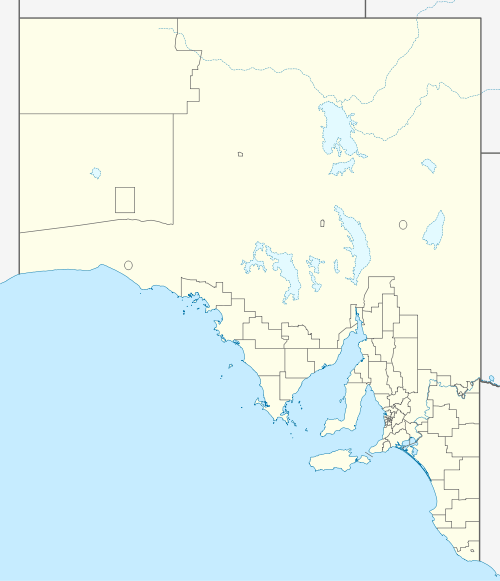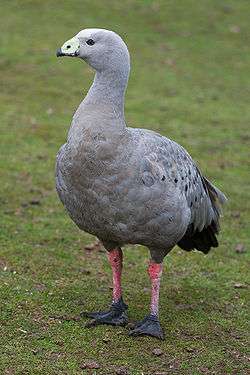Investigator Group
The Investigator Group is an archipelago in South Australia that consists of Flinders Island and five island groups located off the western coast of the Eyre Peninsula. It is named after HMS Investigator by her commander, Matthew Flinders when he explored the area in 1802. The Group lies within the Great Australian Bight. All the islands except Flinders Island, and a part of Pearson Island, are within the Investigator Group Wilderness Protection Area and the Waldegrave Islands Conservation Park.
 Investigator Group | |
| Geography | |
|---|---|
| Location | Great Australian Bight |
| Coordinates | 33°45′S 134°30′E |
| Administration | |
Australia | |

Description
Generally
The Investigator Group is a group of islands and associated landforms that are located within an area extending for a distance of about 70 kilometres (38 nmi) south west from Cape Finniss on the west coast of Eyre Peninsula in South Australia. The group consists of the following islands and island groups placed in order of increasing distance from Cape Finniss: the Waldegrave Islands, The Watchers, Flinders Island, Topgallant Islands, the Ward Islands and the Pearson Isles.[1]
Waldgrave Islands
The northernmost group lies 3 km offshore near the small town of Elliston. It consists of Waldegrave (292 ha) and Little Waldegrave (32 ha) Islands. They have calcarenite soils and were grazed by sheep until 1967. The vegetation is mainly regenerating pasture, with patches of native shrubland dominated by Native Juniper and Coast Daisy-bush.[2]
The Watchers
The Watchers are a pair of rocks that are spaced about 1.9 kilometres (1 nmi) apart and which are located about 3.1 kilometres (1.7 nmi) west of Little Waldegrave Island. The western rock has a charted height of 7 metres (23 feet) and is reported in another source as being 7.3 metres (24 feet). The eastern rock is charted as an intertidal reef.[3][4][5][6][1]
Flinders Island
Flinders Island, which is 28 km offshore and at 36 km2 is the largest island in the Investigator Group. Flinders Island is leasehold land used for grazing. It has sandy, calcarenite soils, is mainly vegetated with pasture grasses, and has some remnant patches of heathland and Melaleuca woodland.[2]
Topgallant Islands
Topgallant Islands are located 6 km to the east of Flinders Islands and is a small island with steep cliffs and some stunted shrubland.[2]
Ward Islands
Ward Islands are located 16 km to the west of Flinders Island and is covered with shrubland and heathland.[2]
Pearson Isles
The southernmost group consists of Pearson Island (213 ha), the Veteran Isles (14 ha) and Dorothee Island (56 ha). Pearson Island, the second largest of the whole Investigator Group, and containing its highest point at 231 m above sea level, is vegetated with shrub and heathland with patches of Casuarina and Melaleuca woodland. The Veteran Isles support low shrubland dominated by Twiggy Daisy-bush and Marsh Saltbush. Lying 3 km south-south-west of the Veteran Isles is Dorothee Island, the most southerly of the Investigator Group.[2][7]
History
European discovery
On Saturday, 13 February 1802, Flinders gave the name Investigator Group to the group of islands consisting of Flinders Island, the Pearson Islands, the Topgallant Islands, the Waldegrave Islands and Ward Islands.[8]
Protected area status and other designations
Reserves declared by the South Australian government
Protected area status has been conferred to all islands within the group with exception of the majority of Flinders Island and part of Pearson Island.[9][10] The Investigator Group Wilderness Protection Area comprises Ward Islands, Top Gallant Isles, Pearson Isles with exception of a portion of land on Pearson Island which is held by the Australian Maritime Safety Authority for "lighthouse purposes".[9] The Waldegrave Islands Conservation Park occupies the Waldegrave Island, Little Waldegrave Island and the Watchers.[10] A heritage agreement has been in force on Flinders Island since 1995 in respect to a strip of land along the north coast of the island extending west from the island’s most northerly headland, Point Malcolm.[11][2] As of 2012, the Investigator Marine Park includes the waters adjoining Flinders Island, Topgallant Isles, the Ward Islands and the Pearson Isles.[12]
Non-statutory arrangements
Investigator Islands Important Bird Area
The group has been identified by BirdLife International as an Important Bird Area (IBA) known as the Investigator Islands (sic) Important Bird Area because it is considered to support over 1% of the world population of Cape Barren geese and a population of the vulnerable fairy tern. The IBA probably also supports over 1% of the world populations of black-faced cormorants and Pacific gulls. Other birds for which the IBA is significant include large numbers of breeding short-tailed shearwaters and white-faced storm-petrels. The biome-restricted rock parrot has been recorded from most islands in the group.[2]
See also
Citations and references
Citations
- Sailing Directions (Enroute), Pub. 175: North, West, and South Coasts of Australia (PDF). Sailing Directions. United States National Geospatial-Intelligence Agency. 2017. p. 178-179.
- BLI, 2015
- RAN, 1979
- DMH, 1985, chart 38
- Robinson et al., 1996, page 188
- "The Watchers". Gazetteer of Australia online. Geoscience Australia, Australian Government.
- Geoscience Australia, 1983. Topgallant 5730 1:100,000 topographic map, Edition 1.
- Flinders, 1814 (1966), page 223
- WAC, 2013, pages 16-17
- DEH, 2006, page 5
- DEH, 2006, page 12
- DEWNR, 2012, pages 23 & 26
References
- "Terrestrial Protected Areas of South Australia (see 'DETAIL' tab)". CAPAD 2012. Australian Government - Department of the Environment (DoE). 6 February 2014. Retrieved 6 February 2014.
- "Wilderness Advisory Committee (WAC) Annual Report 2012-13" (PDF). September 2013. ISSN 1832-9357. Retrieved 17 March 2014. Cite journal requires
|journal=(help) - "Important Bird Areas factsheet: Investigator Islands (sic)". Birdata. Birds Australia. 2015. Retrieved 2 January 2015.
- Flinders, Matthew (1966) [1814]. A Voyage to Terra Australis : undertaken for the purpose of completing the discovery of that vast country, and prosecuted in the years 1801, 1802, and 1803 in His Majesty's ship the Investigator, and subsequently in the armed vessel Porpoise and Cumberland Schooner; with an account of the shipwreck of the Porpoise, arrival of the Cumberland at Mauritius, and imprisonment of the commander during six years and a half in that island (Facsimile ed.). Adelaide; Facsimile reprint of: London : G. and W. Nicol, 1814 ed. In two volumes, with an Atlas (3 volumes): Libraries Board of South Australia. Retrieved 5 January 2014.CS1 maint: location (link)
- South Australia. Department of Marine and Harbors (DMH) (1985), The Waters of South Australia a series of charts, sailing notes and coastal photographs, Dept. of Marine and Harbors, South Australia, ISBN 978-0-7243-7603-2
- Royal Australian Navy (RAN) Hydrographic Service Hydrographic Department (1979). Streaky Bay to Whidbey Islands (chart no. Aus 342).
- Robinson, A. C.; Canty, P.; Mooney, T.; Rudduck, P. (1996). "South Australia's offshore islands" (PDF). Australian Heritage Commission. ISBN 978-0-644-35011-2. Retrieved 13 December 2013.
- Anon (2006). Island Parks of Western Eyre Peninsula Management Plan (PDF). Adelaide: Department for Environment and Heritage, South Australia. ISBN 1-921238-18-6.
- Investigator Marine Park Management Plan 2012 (PDF). Adelaide: Department for Environment Water and Natural Resources (DEWNR). 2012.